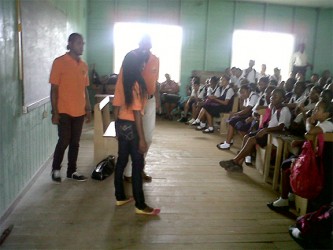By Dacia Whaul
As the fatal results of gender-based violence cases continue to capture national attention, Merundoi Incorporated is seeking to turn the tide through its ongoing examination of the causes, and grassroots outreaches designed to change behaviour.
Now in the fourth season of the Merundoi radio serial drama, there is a continued focus on gender-based violence and Merundoi’s Project Manager Durwin Humphrey says it was prompted by the increasing trend found by research conducted by various bodies. As a result, a decision was taken to continue the gender-based violence focus that was started in season three of the radio serial drama. “Not only was there domestic violence to the extent of just mild violence,” Humphrey said, “the violence was becoming so serious that we noticed that spouses were basically killing each other along with families.”
Humphrey added that gender-based violence seemed to be affecting society on several levels. “Children were being affected, women in their workplaces and men as well,” he stated, while noting that male victims of abuse are hardly reported on.

Additionally, Humphrey said that Merundoi wanted to build on the momentum gained in season three. He said that in season four, the length of the radio serial drama has increased and he opined that it is a “scale up” for the Modelling and Reinforcement to Combat Domestic Violence project, for which Merundoi Inc has received funding to the tune of 137,222 euros ($39.1 million) from the European Instrument for Democracy and Human Rights (EIDHR). The current project will last for two years and will allow Merundoi to examine the multifaceted nature of gender-based violence.
Humphrey explained that gender-based involves not only what appears on the surface, and what is reported in the media. He said what appears in the media is all a manifestation of gender-based violence and what needs to be examined, as a society, “are certain causes that lead to the effect,” such as financial issues, psychosocial issues and psychological issues. He added that it varies by communities and ethnicity.
Merundoi is produced under a strategy called Modelling And Reinforcement (MAR). “We Model behaviours through the radio drama,” Humphrey explained. He used the example of the character “Fineman” to illustrate the transition a character may undergo. He said Fineman moved from the stage of being very abusive to his wife to a point where he became an advocate for non-violence in relationships. “Based on how our listening audience follows that storyline,” he stated, “they get to see how the character makes the change and they can apply it to their lives.”
The reinforcement part of the strategy, he added, is where the model is taken to the grassroots level. Humphrey said Merundoi has trained facilitators in the various regions of Guyana to implement listening and discussion groups.
He said the facilitators play an episode of Merundoi focusing on the issue, or zoom in on a particular scene to the selected target audience, such as teenagers, men or women who were either victims of abuse or affected by abuse. The listening session is followed up with a discussion geared at generating solutions. Humphrey opined that from a practical perspective, people can apply the skills learned to their lives and enhance their ability to cope with conflict in their homes.
For last year, there were 29 domestic violence-related murders and 21 of the victims were women and girls.
According to statistics recorded by Stabroek News, the first murder was on January 16 and the last on December 31. Six of the victims were children, with the youngest being eight-months-old and the oldest 15. In addition, two 17-year-old girls were among the victims.
In seven of the cases, the perpetrators succeeded in subsequently taking their own lives, while in two instances their attempts to do so failed.
Fourteen persons, one woman among them, have since been charged with murder in relation to these cases.





